Management and Operations: Roles of Leaders and Managers, Approaches to Operations Management, and Importance for Business Objectives
VerifiedAdded on 2023/06/18
|13
|4128
|262
AI Summary
This report discusses the roles and characteristics of leaders and managers, different approaches to operations management, and the importance of operations management for achieving business objectives. The report focuses on Burberry, a luxury fashion store, and its operations management strategies. It is divided into two parts, with the first part discussing the roles and characteristics of leaders and managers, and the second part elaborating on the key approaches to operations management and the role played by leaders and managers. The report also discusses the importance of operations management in achieving business objectives.
Contribute Materials
Your contribution can guide someone’s learning journey. Share your
documents today.
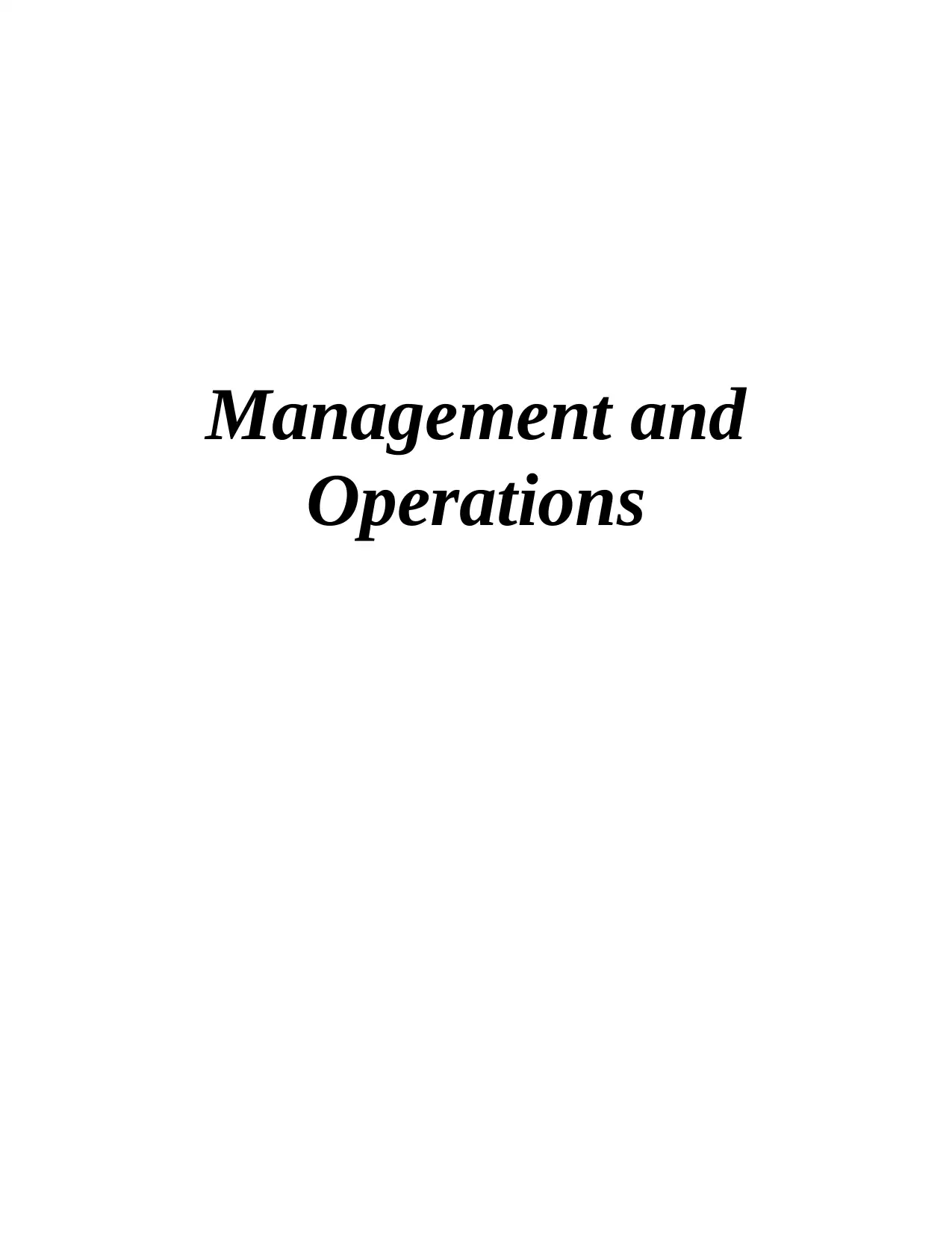
Management and
Operations
Operations
Secure Best Marks with AI Grader
Need help grading? Try our AI Grader for instant feedback on your assignments.
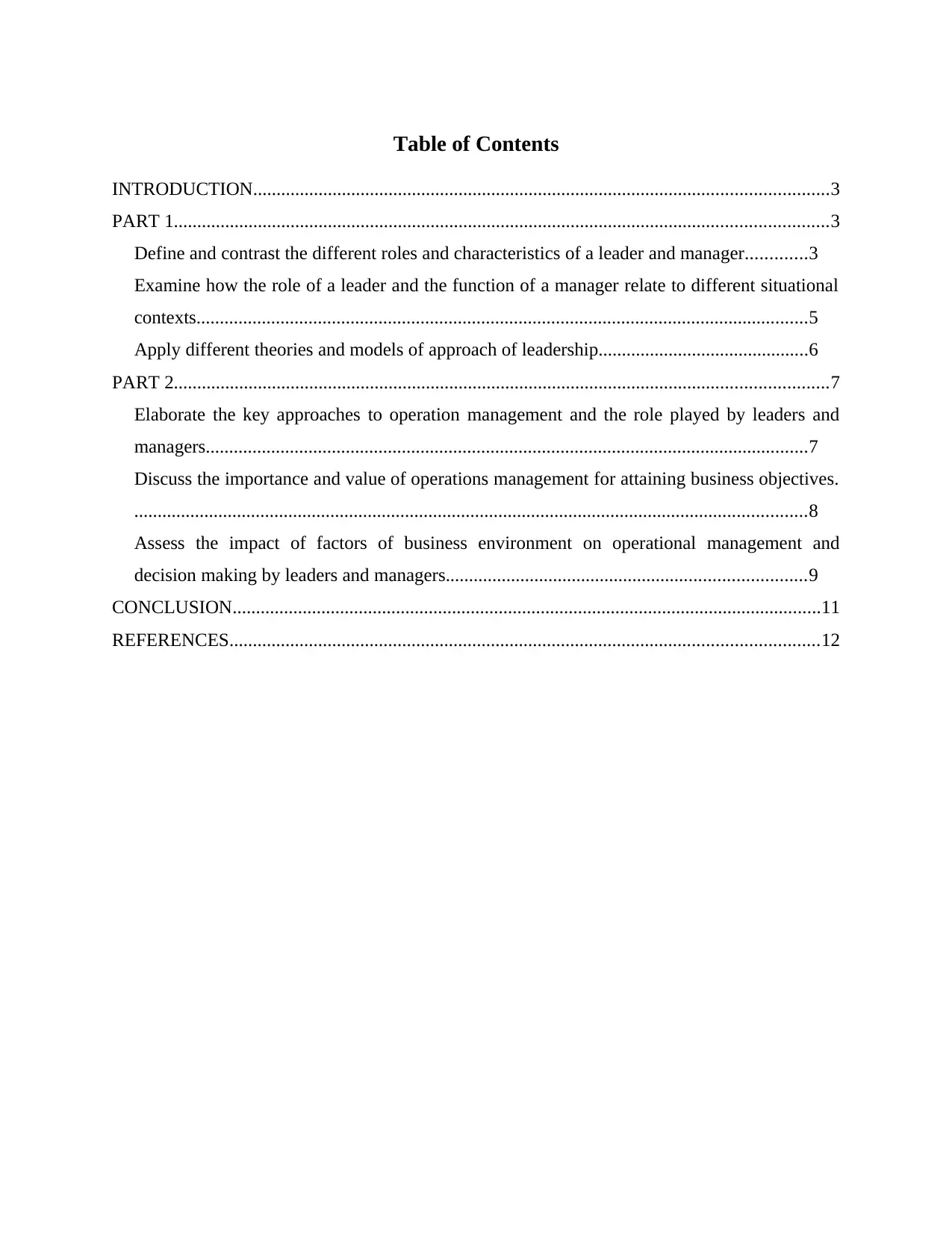
Table of Contents
INTRODUCTION...........................................................................................................................3
PART 1............................................................................................................................................3
Define and contrast the different roles and characteristics of a leader and manager.............3
Examine how the role of a leader and the function of a manager relate to different situational
contexts...................................................................................................................................5
Apply different theories and models of approach of leadership.............................................6
PART 2............................................................................................................................................7
Elaborate the key approaches to operation management and the role played by leaders and
managers.................................................................................................................................7
Discuss the importance and value of operations management for attaining business objectives.
................................................................................................................................................8
Assess the impact of factors of business environment on operational management and
decision making by leaders and managers.............................................................................9
CONCLUSION..............................................................................................................................11
REFERENCES..............................................................................................................................12
INTRODUCTION...........................................................................................................................3
PART 1............................................................................................................................................3
Define and contrast the different roles and characteristics of a leader and manager.............3
Examine how the role of a leader and the function of a manager relate to different situational
contexts...................................................................................................................................5
Apply different theories and models of approach of leadership.............................................6
PART 2............................................................................................................................................7
Elaborate the key approaches to operation management and the role played by leaders and
managers.................................................................................................................................7
Discuss the importance and value of operations management for attaining business objectives.
................................................................................................................................................8
Assess the impact of factors of business environment on operational management and
decision making by leaders and managers.............................................................................9
CONCLUSION..............................................................................................................................11
REFERENCES..............................................................................................................................12
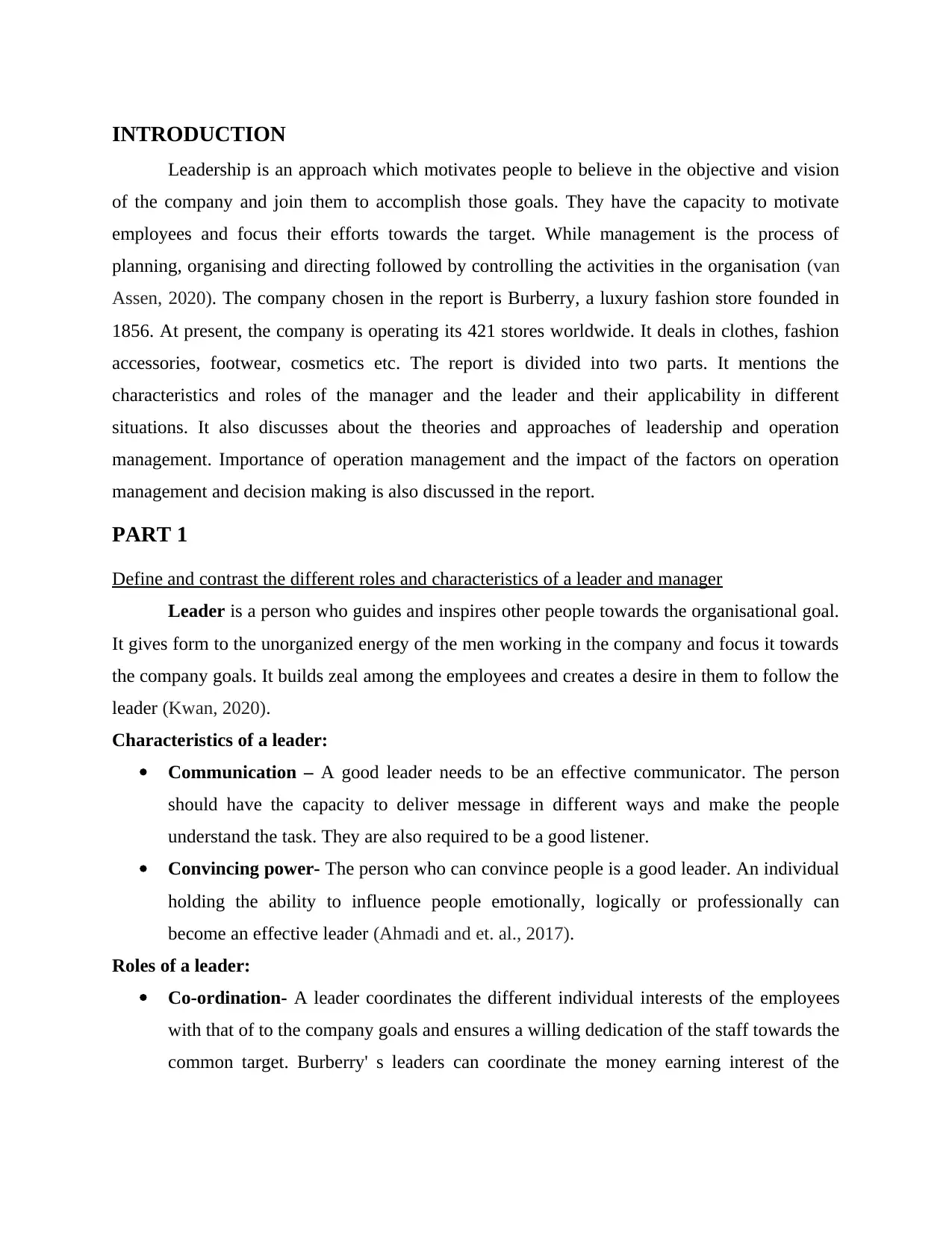
INTRODUCTION
Leadership is an approach which motivates people to believe in the objective and vision
of the company and join them to accomplish those goals. They have the capacity to motivate
employees and focus their efforts towards the target. While management is the process of
planning, organising and directing followed by controlling the activities in the organisation (van
Assen, 2020). The company chosen in the report is Burberry, a luxury fashion store founded in
1856. At present, the company is operating its 421 stores worldwide. It deals in clothes, fashion
accessories, footwear, cosmetics etc. The report is divided into two parts. It mentions the
characteristics and roles of the manager and the leader and their applicability in different
situations. It also discusses about the theories and approaches of leadership and operation
management. Importance of operation management and the impact of the factors on operation
management and decision making is also discussed in the report.
PART 1
Define and contrast the different roles and characteristics of a leader and manager
Leader is a person who guides and inspires other people towards the organisational goal.
It gives form to the unorganized energy of the men working in the company and focus it towards
the company goals. It builds zeal among the employees and creates a desire in them to follow the
leader (Kwan, 2020).
Characteristics of a leader:
Communication – A good leader needs to be an effective communicator. The person
should have the capacity to deliver message in different ways and make the people
understand the task. They are also required to be a good listener.
Convincing power- The person who can convince people is a good leader. An individual
holding the ability to influence people emotionally, logically or professionally can
become an effective leader (Ahmadi and et. al., 2017).
Roles of a leader:
Co-ordination- A leader coordinates the different individual interests of the employees
with that of to the company goals and ensures a willing dedication of the staff towards the
common target. Burberry' s leaders can coordinate the money earning interest of the
Leadership is an approach which motivates people to believe in the objective and vision
of the company and join them to accomplish those goals. They have the capacity to motivate
employees and focus their efforts towards the target. While management is the process of
planning, organising and directing followed by controlling the activities in the organisation (van
Assen, 2020). The company chosen in the report is Burberry, a luxury fashion store founded in
1856. At present, the company is operating its 421 stores worldwide. It deals in clothes, fashion
accessories, footwear, cosmetics etc. The report is divided into two parts. It mentions the
characteristics and roles of the manager and the leader and their applicability in different
situations. It also discusses about the theories and approaches of leadership and operation
management. Importance of operation management and the impact of the factors on operation
management and decision making is also discussed in the report.
PART 1
Define and contrast the different roles and characteristics of a leader and manager
Leader is a person who guides and inspires other people towards the organisational goal.
It gives form to the unorganized energy of the men working in the company and focus it towards
the company goals. It builds zeal among the employees and creates a desire in them to follow the
leader (Kwan, 2020).
Characteristics of a leader:
Communication – A good leader needs to be an effective communicator. The person
should have the capacity to deliver message in different ways and make the people
understand the task. They are also required to be a good listener.
Convincing power- The person who can convince people is a good leader. An individual
holding the ability to influence people emotionally, logically or professionally can
become an effective leader (Ahmadi and et. al., 2017).
Roles of a leader:
Co-ordination- A leader coordinates the different individual interests of the employees
with that of to the company goals and ensures a willing dedication of the staff towards the
common target. Burberry' s leaders can coordinate the money earning interest of the
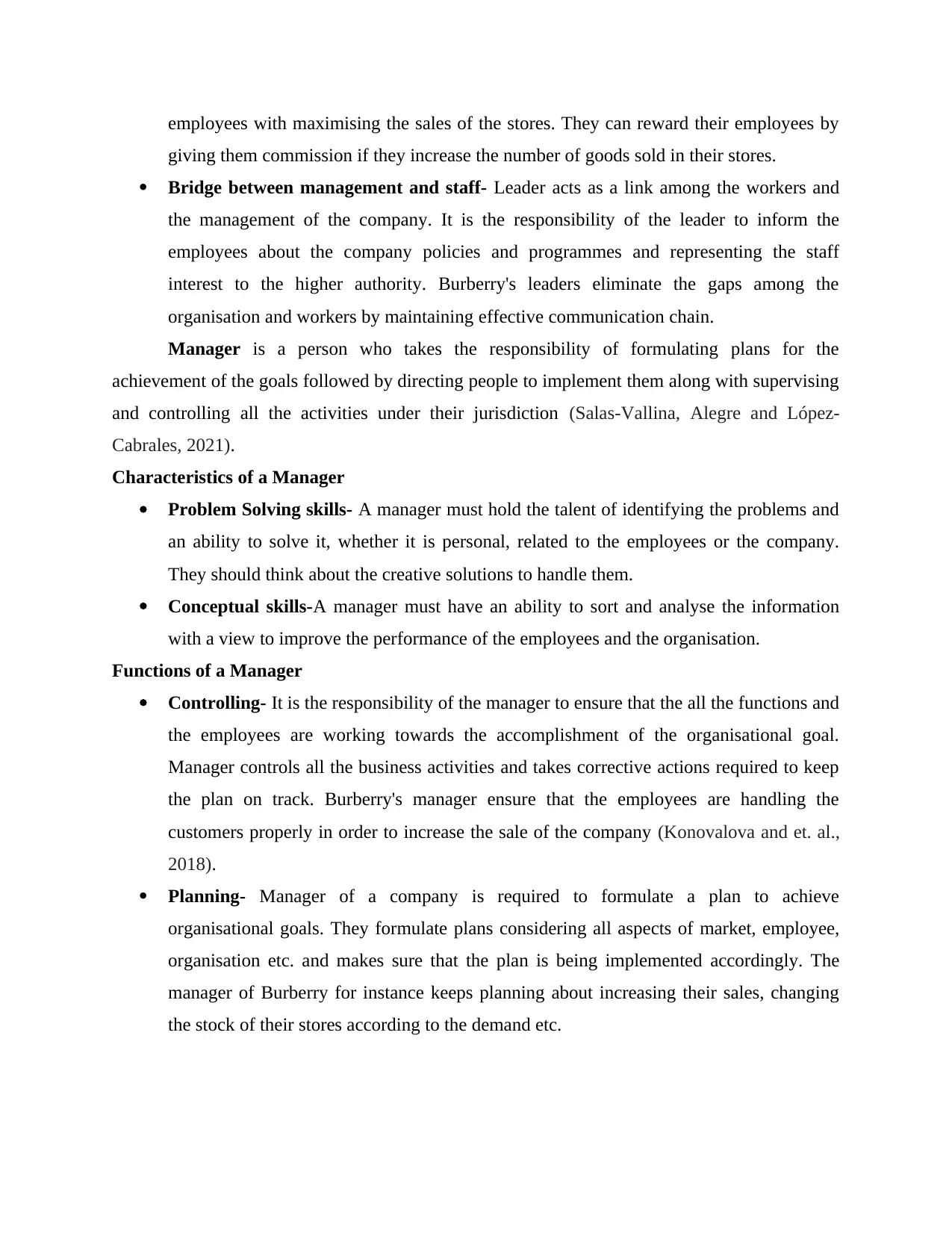
employees with maximising the sales of the stores. They can reward their employees by
giving them commission if they increase the number of goods sold in their stores.
Bridge between management and staff- Leader acts as a link among the workers and
the management of the company. It is the responsibility of the leader to inform the
employees about the company policies and programmes and representing the staff
interest to the higher authority. Burberry's leaders eliminate the gaps among the
organisation and workers by maintaining effective communication chain.
Manager is a person who takes the responsibility of formulating plans for the
achievement of the goals followed by directing people to implement them along with supervising
and controlling all the activities under their jurisdiction (Salas‐Vallina, Alegre and López‐
Cabrales, 2021).
Characteristics of a Manager
Problem Solving skills- A manager must hold the talent of identifying the problems and
an ability to solve it, whether it is personal, related to the employees or the company.
They should think about the creative solutions to handle them.
Conceptual skills-A manager must have an ability to sort and analyse the information
with a view to improve the performance of the employees and the organisation.
Functions of a Manager
Controlling- It is the responsibility of the manager to ensure that the all the functions and
the employees are working towards the accomplishment of the organisational goal.
Manager controls all the business activities and takes corrective actions required to keep
the plan on track. Burberry's manager ensure that the employees are handling the
customers properly in order to increase the sale of the company (Konovalova and et. al.,
2018).
Planning- Manager of a company is required to formulate a plan to achieve
organisational goals. They formulate plans considering all aspects of market, employee,
organisation etc. and makes sure that the plan is being implemented accordingly. The
manager of Burberry for instance keeps planning about increasing their sales, changing
the stock of their stores according to the demand etc.
giving them commission if they increase the number of goods sold in their stores.
Bridge between management and staff- Leader acts as a link among the workers and
the management of the company. It is the responsibility of the leader to inform the
employees about the company policies and programmes and representing the staff
interest to the higher authority. Burberry's leaders eliminate the gaps among the
organisation and workers by maintaining effective communication chain.
Manager is a person who takes the responsibility of formulating plans for the
achievement of the goals followed by directing people to implement them along with supervising
and controlling all the activities under their jurisdiction (Salas‐Vallina, Alegre and López‐
Cabrales, 2021).
Characteristics of a Manager
Problem Solving skills- A manager must hold the talent of identifying the problems and
an ability to solve it, whether it is personal, related to the employees or the company.
They should think about the creative solutions to handle them.
Conceptual skills-A manager must have an ability to sort and analyse the information
with a view to improve the performance of the employees and the organisation.
Functions of a Manager
Controlling- It is the responsibility of the manager to ensure that the all the functions and
the employees are working towards the accomplishment of the organisational goal.
Manager controls all the business activities and takes corrective actions required to keep
the plan on track. Burberry's manager ensure that the employees are handling the
customers properly in order to increase the sale of the company (Konovalova and et. al.,
2018).
Planning- Manager of a company is required to formulate a plan to achieve
organisational goals. They formulate plans considering all aspects of market, employee,
organisation etc. and makes sure that the plan is being implemented accordingly. The
manager of Burberry for instance keeps planning about increasing their sales, changing
the stock of their stores according to the demand etc.
Secure Best Marks with AI Grader
Need help grading? Try our AI Grader for instant feedback on your assignments.
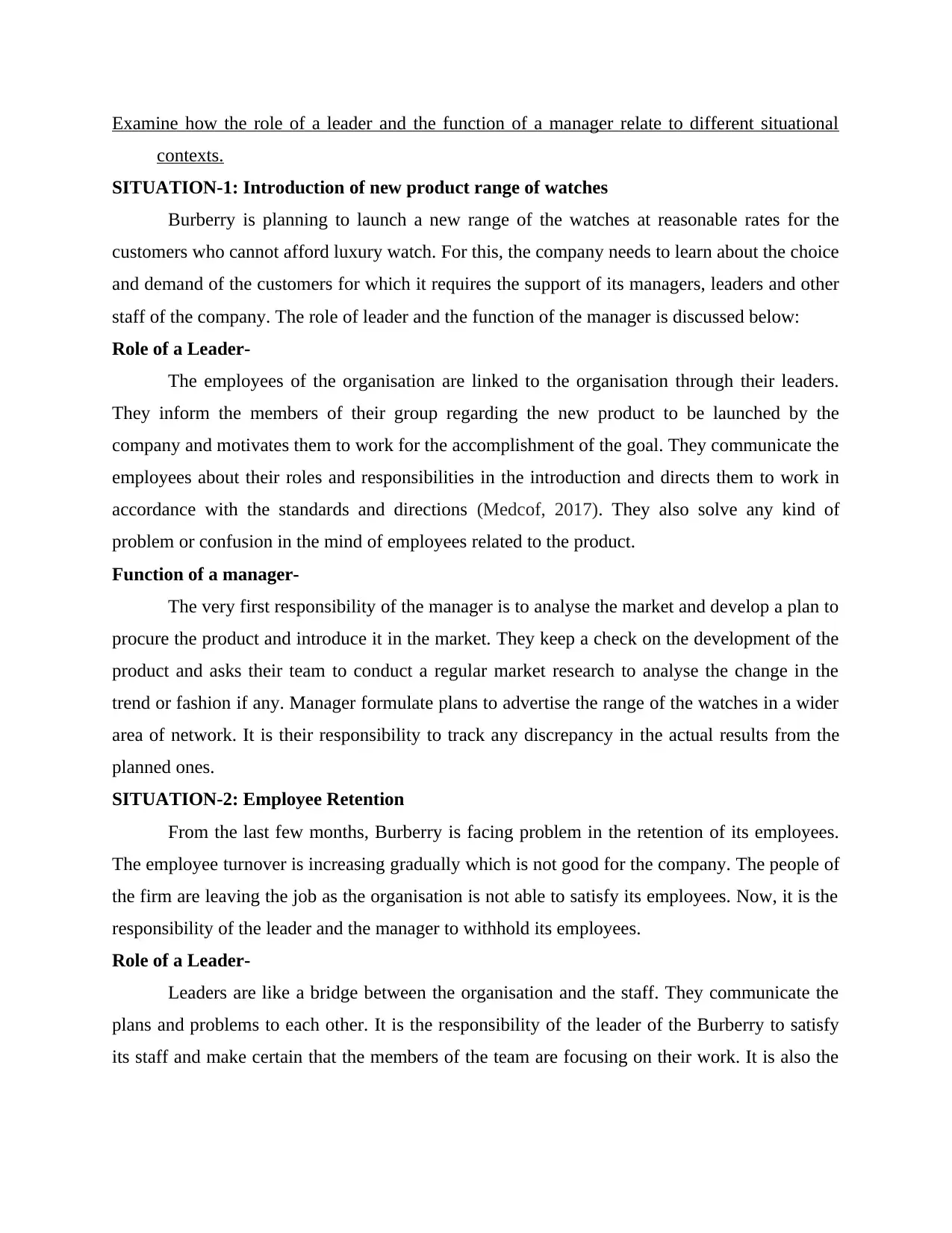
Examine how the role of a leader and the function of a manager relate to different situational
contexts.
SITUATION-1: Introduction of new product range of watches
Burberry is planning to launch a new range of the watches at reasonable rates for the
customers who cannot afford luxury watch. For this, the company needs to learn about the choice
and demand of the customers for which it requires the support of its managers, leaders and other
staff of the company. The role of leader and the function of the manager is discussed below:
Role of a Leader-
The employees of the organisation are linked to the organisation through their leaders.
They inform the members of their group regarding the new product to be launched by the
company and motivates them to work for the accomplishment of the goal. They communicate the
employees about their roles and responsibilities in the introduction and directs them to work in
accordance with the standards and directions (Medcof, 2017). They also solve any kind of
problem or confusion in the mind of employees related to the product.
Function of a manager-
The very first responsibility of the manager is to analyse the market and develop a plan to
procure the product and introduce it in the market. They keep a check on the development of the
product and asks their team to conduct a regular market research to analyse the change in the
trend or fashion if any. Manager formulate plans to advertise the range of the watches in a wider
area of network. It is their responsibility to track any discrepancy in the actual results from the
planned ones.
SITUATION-2: Employee Retention
From the last few months, Burberry is facing problem in the retention of its employees.
The employee turnover is increasing gradually which is not good for the company. The people of
the firm are leaving the job as the organisation is not able to satisfy its employees. Now, it is the
responsibility of the leader and the manager to withhold its employees.
Role of a Leader-
Leaders are like a bridge between the organisation and the staff. They communicate the
plans and problems to each other. It is the responsibility of the leader of the Burberry to satisfy
its staff and make certain that the members of the team are focusing on their work. It is also the
contexts.
SITUATION-1: Introduction of new product range of watches
Burberry is planning to launch a new range of the watches at reasonable rates for the
customers who cannot afford luxury watch. For this, the company needs to learn about the choice
and demand of the customers for which it requires the support of its managers, leaders and other
staff of the company. The role of leader and the function of the manager is discussed below:
Role of a Leader-
The employees of the organisation are linked to the organisation through their leaders.
They inform the members of their group regarding the new product to be launched by the
company and motivates them to work for the accomplishment of the goal. They communicate the
employees about their roles and responsibilities in the introduction and directs them to work in
accordance with the standards and directions (Medcof, 2017). They also solve any kind of
problem or confusion in the mind of employees related to the product.
Function of a manager-
The very first responsibility of the manager is to analyse the market and develop a plan to
procure the product and introduce it in the market. They keep a check on the development of the
product and asks their team to conduct a regular market research to analyse the change in the
trend or fashion if any. Manager formulate plans to advertise the range of the watches in a wider
area of network. It is their responsibility to track any discrepancy in the actual results from the
planned ones.
SITUATION-2: Employee Retention
From the last few months, Burberry is facing problem in the retention of its employees.
The employee turnover is increasing gradually which is not good for the company. The people of
the firm are leaving the job as the organisation is not able to satisfy its employees. Now, it is the
responsibility of the leader and the manager to withhold its employees.
Role of a Leader-
Leaders are like a bridge between the organisation and the staff. They communicate the
plans and problems to each other. It is the responsibility of the leader of the Burberry to satisfy
its staff and make certain that the members of the team are focusing on their work. It is also the
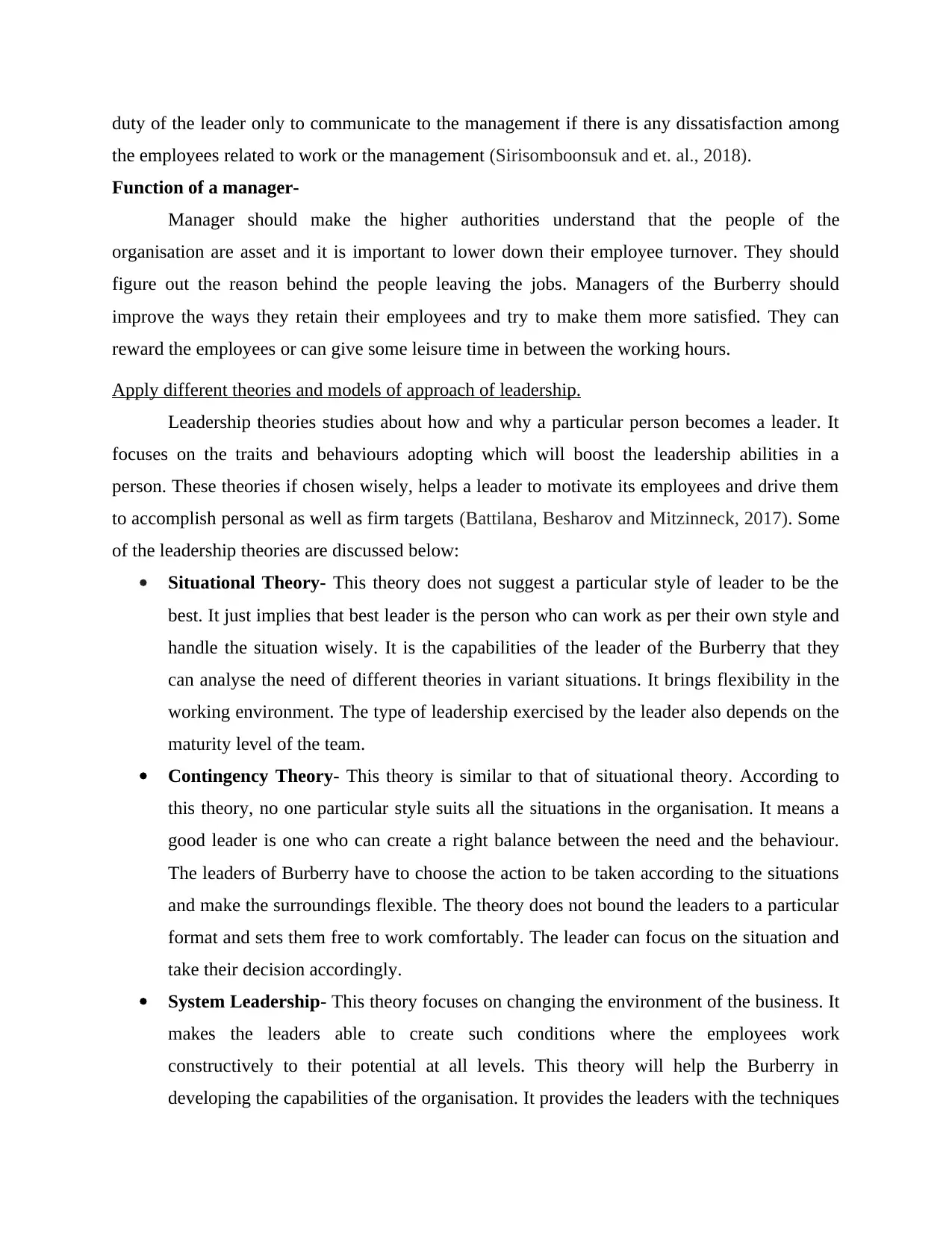
duty of the leader only to communicate to the management if there is any dissatisfaction among
the employees related to work or the management (Sirisomboonsuk and et. al., 2018).
Function of a manager-
Manager should make the higher authorities understand that the people of the
organisation are asset and it is important to lower down their employee turnover. They should
figure out the reason behind the people leaving the jobs. Managers of the Burberry should
improve the ways they retain their employees and try to make them more satisfied. They can
reward the employees or can give some leisure time in between the working hours.
Apply different theories and models of approach of leadership.
Leadership theories studies about how and why a particular person becomes a leader. It
focuses on the traits and behaviours adopting which will boost the leadership abilities in a
person. These theories if chosen wisely, helps a leader to motivate its employees and drive them
to accomplish personal as well as firm targets (Battilana, Besharov and Mitzinneck, 2017). Some
of the leadership theories are discussed below:
Situational Theory- This theory does not suggest a particular style of leader to be the
best. It just implies that best leader is the person who can work as per their own style and
handle the situation wisely. It is the capabilities of the leader of the Burberry that they
can analyse the need of different theories in variant situations. It brings flexibility in the
working environment. The type of leadership exercised by the leader also depends on the
maturity level of the team.
Contingency Theory- This theory is similar to that of situational theory. According to
this theory, no one particular style suits all the situations in the organisation. It means a
good leader is one who can create a right balance between the need and the behaviour.
The leaders of Burberry have to choose the action to be taken according to the situations
and make the surroundings flexible. The theory does not bound the leaders to a particular
format and sets them free to work comfortably. The leader can focus on the situation and
take their decision accordingly.
System Leadership- This theory focuses on changing the environment of the business. It
makes the leaders able to create such conditions where the employees work
constructively to their potential at all levels. This theory will help the Burberry in
developing the capabilities of the organisation. It provides the leaders with the techniques
the employees related to work or the management (Sirisomboonsuk and et. al., 2018).
Function of a manager-
Manager should make the higher authorities understand that the people of the
organisation are asset and it is important to lower down their employee turnover. They should
figure out the reason behind the people leaving the jobs. Managers of the Burberry should
improve the ways they retain their employees and try to make them more satisfied. They can
reward the employees or can give some leisure time in between the working hours.
Apply different theories and models of approach of leadership.
Leadership theories studies about how and why a particular person becomes a leader. It
focuses on the traits and behaviours adopting which will boost the leadership abilities in a
person. These theories if chosen wisely, helps a leader to motivate its employees and drive them
to accomplish personal as well as firm targets (Battilana, Besharov and Mitzinneck, 2017). Some
of the leadership theories are discussed below:
Situational Theory- This theory does not suggest a particular style of leader to be the
best. It just implies that best leader is the person who can work as per their own style and
handle the situation wisely. It is the capabilities of the leader of the Burberry that they
can analyse the need of different theories in variant situations. It brings flexibility in the
working environment. The type of leadership exercised by the leader also depends on the
maturity level of the team.
Contingency Theory- This theory is similar to that of situational theory. According to
this theory, no one particular style suits all the situations in the organisation. It means a
good leader is one who can create a right balance between the need and the behaviour.
The leaders of Burberry have to choose the action to be taken according to the situations
and make the surroundings flexible. The theory does not bound the leaders to a particular
format and sets them free to work comfortably. The leader can focus on the situation and
take their decision accordingly.
System Leadership- This theory focuses on changing the environment of the business. It
makes the leaders able to create such conditions where the employees work
constructively to their potential at all levels. This theory will help the Burberry in
developing the capabilities of the organisation. It provides the leaders with the techniques
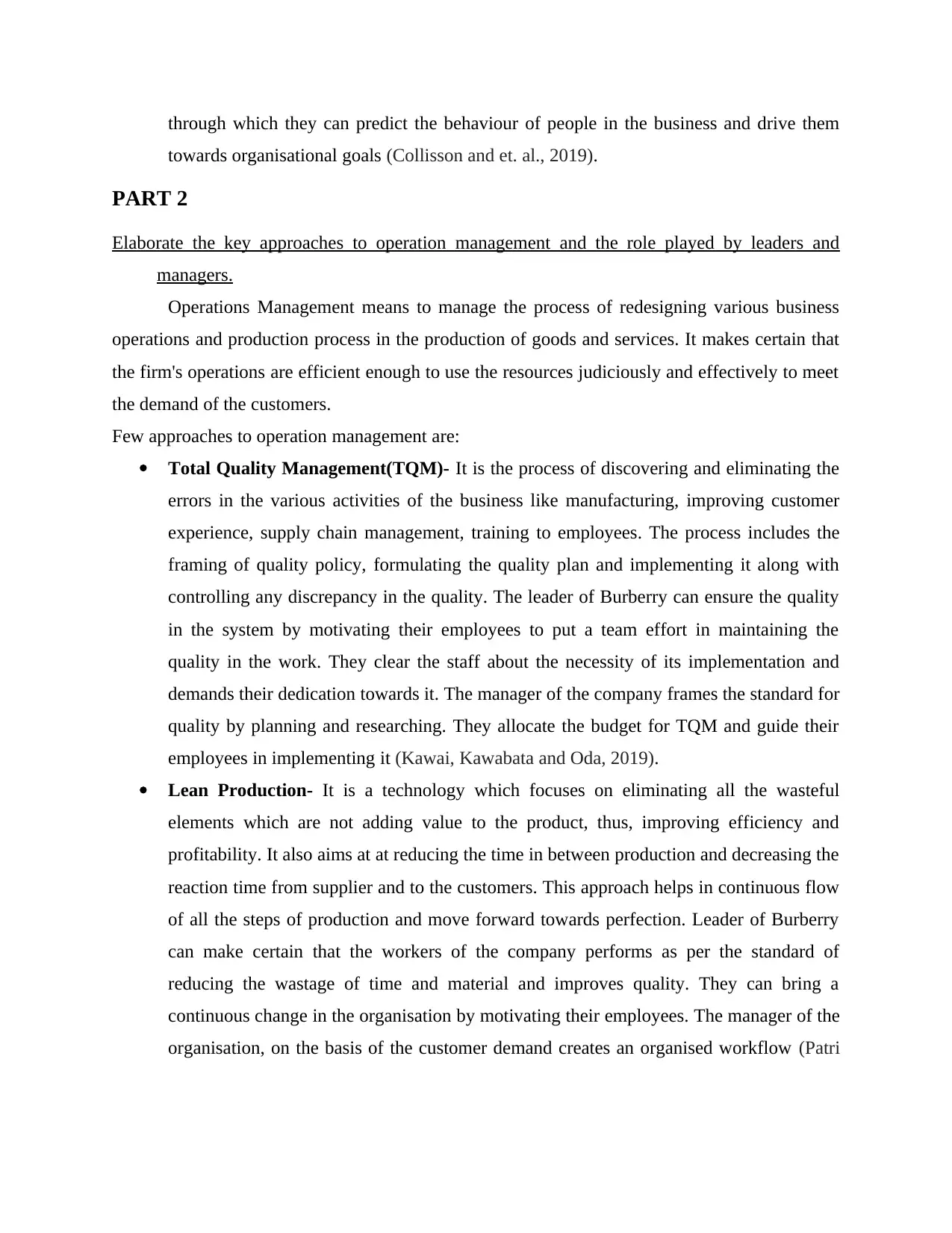
through which they can predict the behaviour of people in the business and drive them
towards organisational goals (Collisson and et. al., 2019).
PART 2
Elaborate the key approaches to operation management and the role played by leaders and
managers.
Operations Management means to manage the process of redesigning various business
operations and production process in the production of goods and services. It makes certain that
the firm's operations are efficient enough to use the resources judiciously and effectively to meet
the demand of the customers.
Few approaches to operation management are:
Total Quality Management(TQM)- It is the process of discovering and eliminating the
errors in the various activities of the business like manufacturing, improving customer
experience, supply chain management, training to employees. The process includes the
framing of quality policy, formulating the quality plan and implementing it along with
controlling any discrepancy in the quality. The leader of Burberry can ensure the quality
in the system by motivating their employees to put a team effort in maintaining the
quality in the work. They clear the staff about the necessity of its implementation and
demands their dedication towards it. The manager of the company frames the standard for
quality by planning and researching. They allocate the budget for TQM and guide their
employees in implementing it (Kawai, Kawabata and Oda, 2019).
Lean Production- It is a technology which focuses on eliminating all the wasteful
elements which are not adding value to the product, thus, improving efficiency and
profitability. It also aims at at reducing the time in between production and decreasing the
reaction time from supplier and to the customers. This approach helps in continuous flow
of all the steps of production and move forward towards perfection. Leader of Burberry
can make certain that the workers of the company performs as per the standard of
reducing the wastage of time and material and improves quality. They can bring a
continuous change in the organisation by motivating their employees. The manager of the
organisation, on the basis of the customer demand creates an organised workflow (Patri
towards organisational goals (Collisson and et. al., 2019).
PART 2
Elaborate the key approaches to operation management and the role played by leaders and
managers.
Operations Management means to manage the process of redesigning various business
operations and production process in the production of goods and services. It makes certain that
the firm's operations are efficient enough to use the resources judiciously and effectively to meet
the demand of the customers.
Few approaches to operation management are:
Total Quality Management(TQM)- It is the process of discovering and eliminating the
errors in the various activities of the business like manufacturing, improving customer
experience, supply chain management, training to employees. The process includes the
framing of quality policy, formulating the quality plan and implementing it along with
controlling any discrepancy in the quality. The leader of Burberry can ensure the quality
in the system by motivating their employees to put a team effort in maintaining the
quality in the work. They clear the staff about the necessity of its implementation and
demands their dedication towards it. The manager of the company frames the standard for
quality by planning and researching. They allocate the budget for TQM and guide their
employees in implementing it (Kawai, Kawabata and Oda, 2019).
Lean Production- It is a technology which focuses on eliminating all the wasteful
elements which are not adding value to the product, thus, improving efficiency and
profitability. It also aims at at reducing the time in between production and decreasing the
reaction time from supplier and to the customers. This approach helps in continuous flow
of all the steps of production and move forward towards perfection. Leader of Burberry
can make certain that the workers of the company performs as per the standard of
reducing the wastage of time and material and improves quality. They can bring a
continuous change in the organisation by motivating their employees. The manager of the
organisation, on the basis of the customer demand creates an organised workflow (Patri
Paraphrase This Document
Need a fresh take? Get an instant paraphrase of this document with our AI Paraphraser
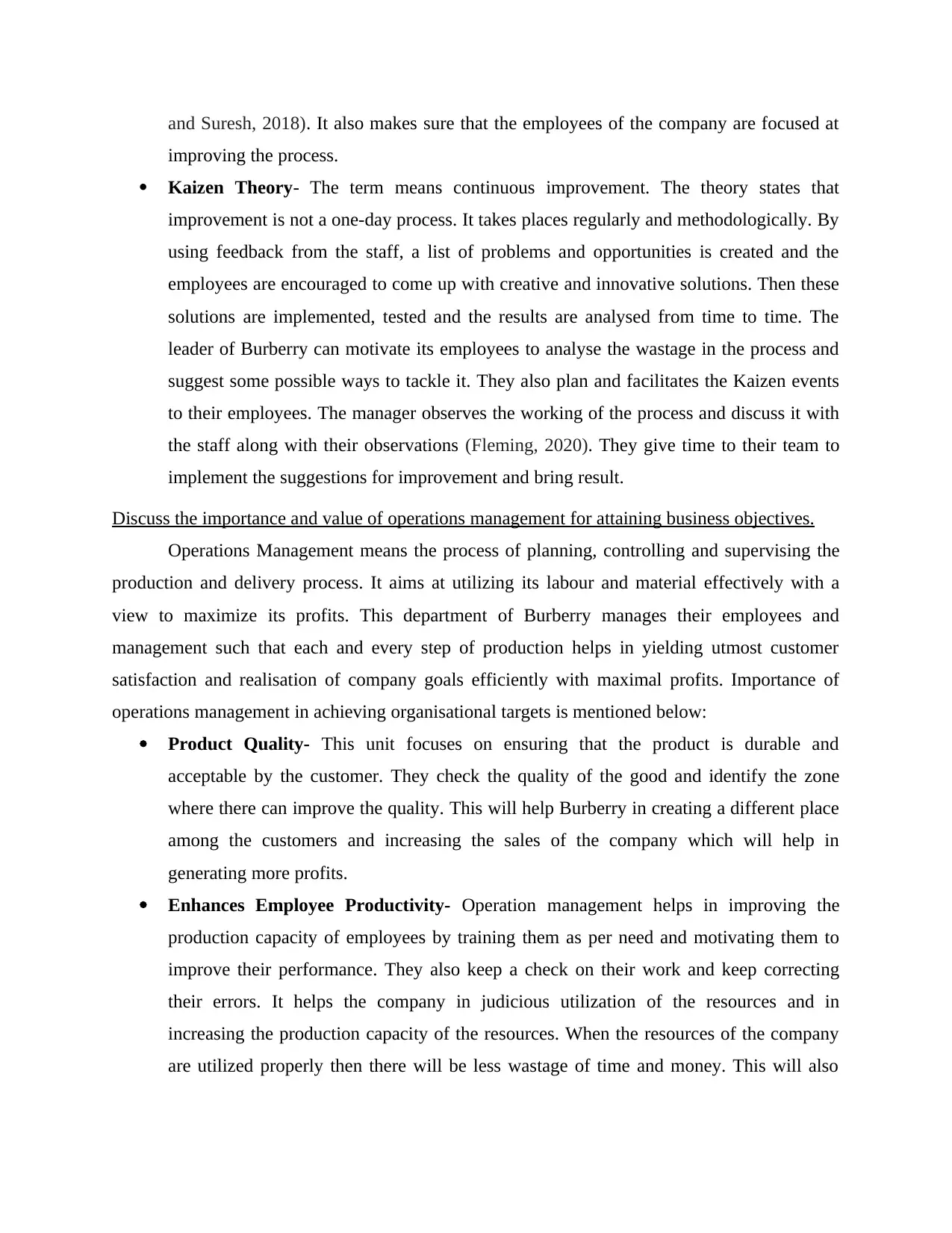
and Suresh, 2018). It also makes sure that the employees of the company are focused at
improving the process.
Kaizen Theory- The term means continuous improvement. The theory states that
improvement is not a one-day process. It takes places regularly and methodologically. By
using feedback from the staff, a list of problems and opportunities is created and the
employees are encouraged to come up with creative and innovative solutions. Then these
solutions are implemented, tested and the results are analysed from time to time. The
leader of Burberry can motivate its employees to analyse the wastage in the process and
suggest some possible ways to tackle it. They also plan and facilitates the Kaizen events
to their employees. The manager observes the working of the process and discuss it with
the staff along with their observations (Fleming, 2020). They give time to their team to
implement the suggestions for improvement and bring result.
Discuss the importance and value of operations management for attaining business objectives.
Operations Management means the process of planning, controlling and supervising the
production and delivery process. It aims at utilizing its labour and material effectively with a
view to maximize its profits. This department of Burberry manages their employees and
management such that each and every step of production helps in yielding utmost customer
satisfaction and realisation of company goals efficiently with maximal profits. Importance of
operations management in achieving organisational targets is mentioned below:
Product Quality- This unit focuses on ensuring that the product is durable and
acceptable by the customer. They check the quality of the good and identify the zone
where there can improve the quality. This will help Burberry in creating a different place
among the customers and increasing the sales of the company which will help in
generating more profits.
Enhances Employee Productivity- Operation management helps in improving the
production capacity of employees by training them as per need and motivating them to
improve their performance. They also keep a check on their work and keep correcting
their errors. It helps the company in judicious utilization of the resources and in
increasing the production capacity of the resources. When the resources of the company
are utilized properly then there will be less wastage of time and money. This will also
improving the process.
Kaizen Theory- The term means continuous improvement. The theory states that
improvement is not a one-day process. It takes places regularly and methodologically. By
using feedback from the staff, a list of problems and opportunities is created and the
employees are encouraged to come up with creative and innovative solutions. Then these
solutions are implemented, tested and the results are analysed from time to time. The
leader of Burberry can motivate its employees to analyse the wastage in the process and
suggest some possible ways to tackle it. They also plan and facilitates the Kaizen events
to their employees. The manager observes the working of the process and discuss it with
the staff along with their observations (Fleming, 2020). They give time to their team to
implement the suggestions for improvement and bring result.
Discuss the importance and value of operations management for attaining business objectives.
Operations Management means the process of planning, controlling and supervising the
production and delivery process. It aims at utilizing its labour and material effectively with a
view to maximize its profits. This department of Burberry manages their employees and
management such that each and every step of production helps in yielding utmost customer
satisfaction and realisation of company goals efficiently with maximal profits. Importance of
operations management in achieving organisational targets is mentioned below:
Product Quality- This unit focuses on ensuring that the product is durable and
acceptable by the customer. They check the quality of the good and identify the zone
where there can improve the quality. This will help Burberry in creating a different place
among the customers and increasing the sales of the company which will help in
generating more profits.
Enhances Employee Productivity- Operation management helps in improving the
production capacity of employees by training them as per need and motivating them to
improve their performance. They also keep a check on their work and keep correcting
their errors. It helps the company in judicious utilization of the resources and in
increasing the production capacity of the resources. When the resources of the company
are utilized properly then there will be less wastage of time and money. This will also
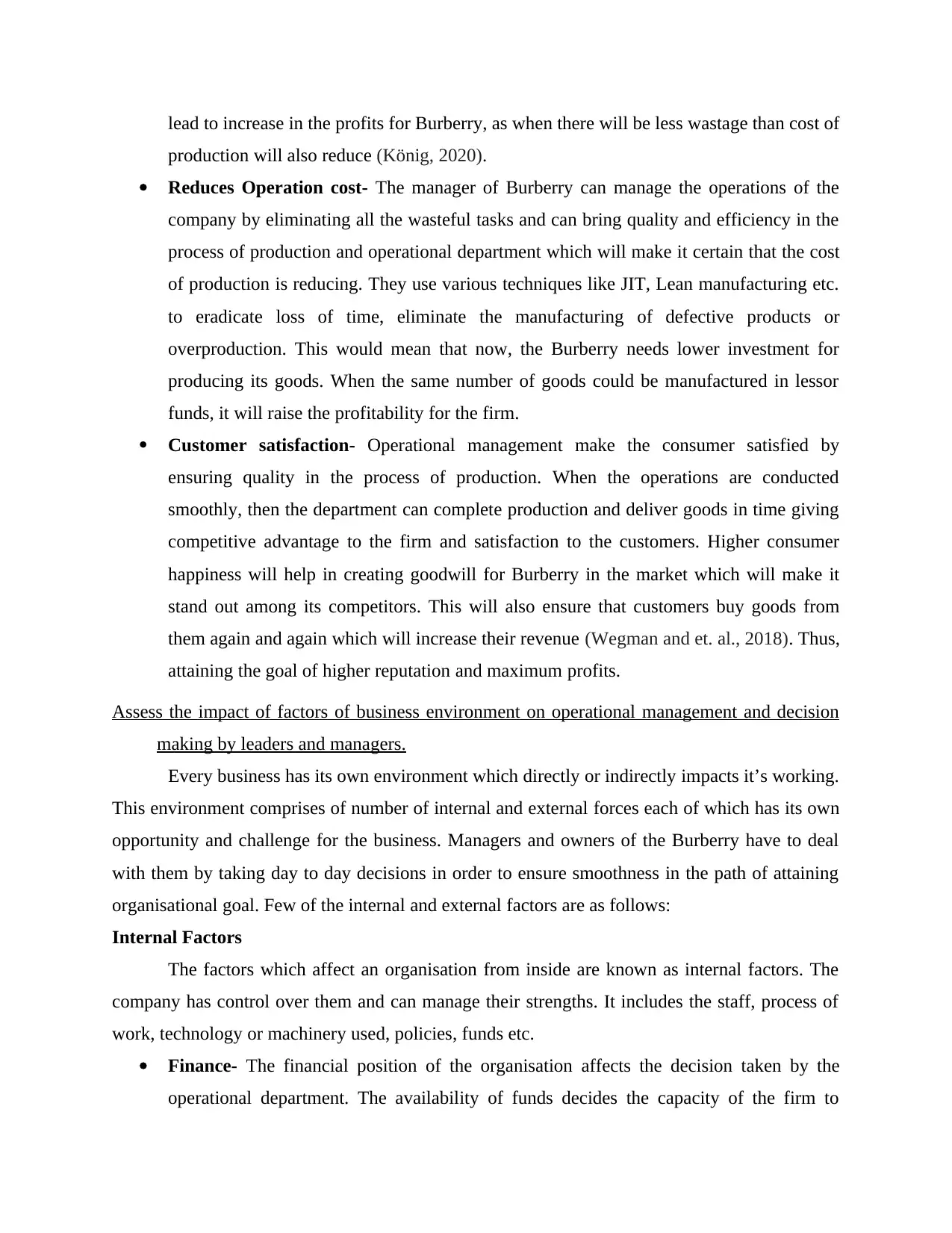
lead to increase in the profits for Burberry, as when there will be less wastage than cost of
production will also reduce (König, 2020).
Reduces Operation cost- The manager of Burberry can manage the operations of the
company by eliminating all the wasteful tasks and can bring quality and efficiency in the
process of production and operational department which will make it certain that the cost
of production is reducing. They use various techniques like JIT, Lean manufacturing etc.
to eradicate loss of time, eliminate the manufacturing of defective products or
overproduction. This would mean that now, the Burberry needs lower investment for
producing its goods. When the same number of goods could be manufactured in lessor
funds, it will raise the profitability for the firm.
Customer satisfaction- Operational management make the consumer satisfied by
ensuring quality in the process of production. When the operations are conducted
smoothly, then the department can complete production and deliver goods in time giving
competitive advantage to the firm and satisfaction to the customers. Higher consumer
happiness will help in creating goodwill for Burberry in the market which will make it
stand out among its competitors. This will also ensure that customers buy goods from
them again and again which will increase their revenue (Wegman and et. al., 2018). Thus,
attaining the goal of higher reputation and maximum profits.
Assess the impact of factors of business environment on operational management and decision
making by leaders and managers.
Every business has its own environment which directly or indirectly impacts it’s working.
This environment comprises of number of internal and external forces each of which has its own
opportunity and challenge for the business. Managers and owners of the Burberry have to deal
with them by taking day to day decisions in order to ensure smoothness in the path of attaining
organisational goal. Few of the internal and external factors are as follows:
Internal Factors
The factors which affect an organisation from inside are known as internal factors. The
company has control over them and can manage their strengths. It includes the staff, process of
work, technology or machinery used, policies, funds etc.
Finance- The financial position of the organisation affects the decision taken by the
operational department. The availability of funds decides the capacity of the firm to
production will also reduce (König, 2020).
Reduces Operation cost- The manager of Burberry can manage the operations of the
company by eliminating all the wasteful tasks and can bring quality and efficiency in the
process of production and operational department which will make it certain that the cost
of production is reducing. They use various techniques like JIT, Lean manufacturing etc.
to eradicate loss of time, eliminate the manufacturing of defective products or
overproduction. This would mean that now, the Burberry needs lower investment for
producing its goods. When the same number of goods could be manufactured in lessor
funds, it will raise the profitability for the firm.
Customer satisfaction- Operational management make the consumer satisfied by
ensuring quality in the process of production. When the operations are conducted
smoothly, then the department can complete production and deliver goods in time giving
competitive advantage to the firm and satisfaction to the customers. Higher consumer
happiness will help in creating goodwill for Burberry in the market which will make it
stand out among its competitors. This will also ensure that customers buy goods from
them again and again which will increase their revenue (Wegman and et. al., 2018). Thus,
attaining the goal of higher reputation and maximum profits.
Assess the impact of factors of business environment on operational management and decision
making by leaders and managers.
Every business has its own environment which directly or indirectly impacts it’s working.
This environment comprises of number of internal and external forces each of which has its own
opportunity and challenge for the business. Managers and owners of the Burberry have to deal
with them by taking day to day decisions in order to ensure smoothness in the path of attaining
organisational goal. Few of the internal and external factors are as follows:
Internal Factors
The factors which affect an organisation from inside are known as internal factors. The
company has control over them and can manage their strengths. It includes the staff, process of
work, technology or machinery used, policies, funds etc.
Finance- The financial position of the organisation affects the decision taken by the
operational department. The availability of funds decides the capacity of the firm to
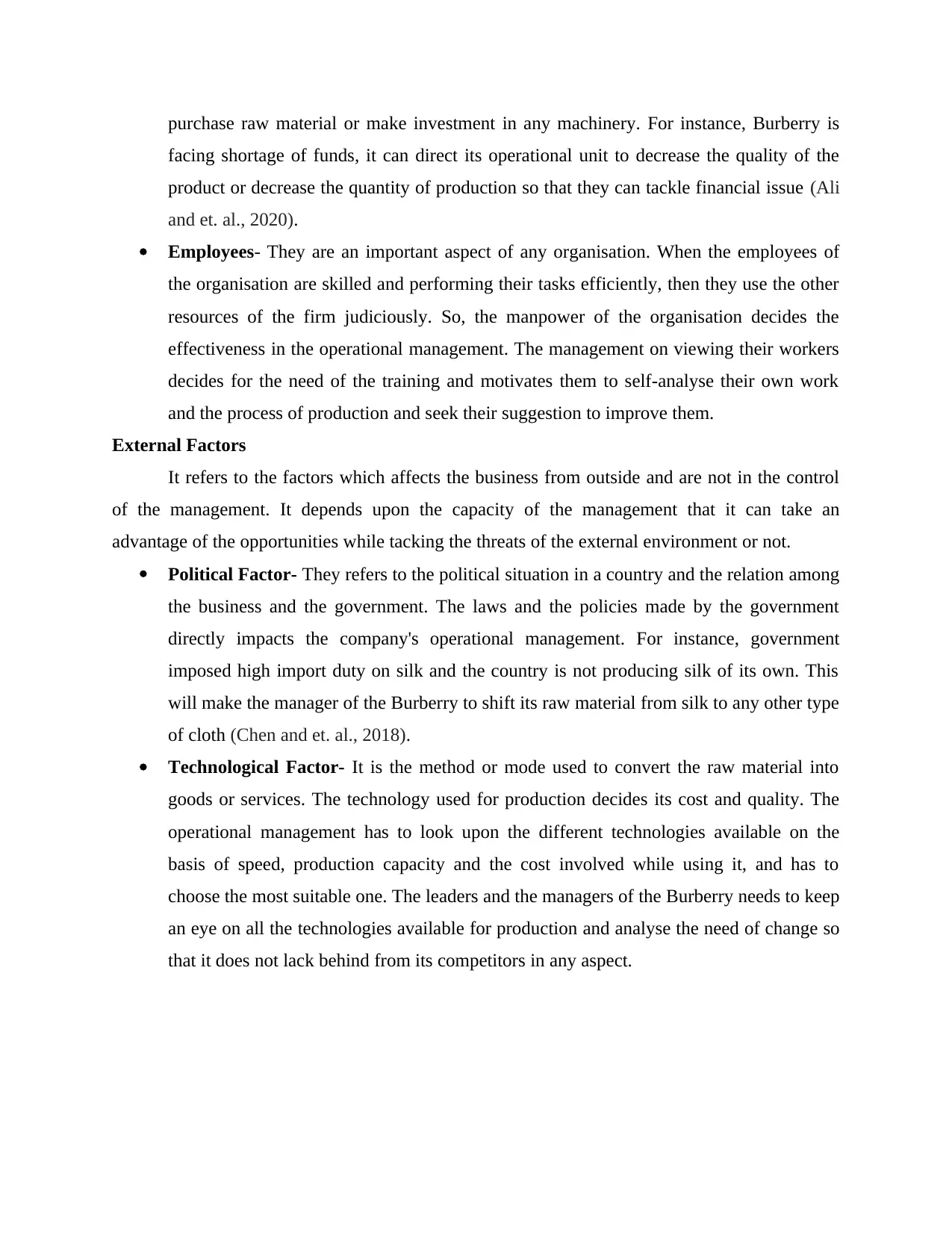
purchase raw material or make investment in any machinery. For instance, Burberry is
facing shortage of funds, it can direct its operational unit to decrease the quality of the
product or decrease the quantity of production so that they can tackle financial issue (Ali
and et. al., 2020).
Employees- They are an important aspect of any organisation. When the employees of
the organisation are skilled and performing their tasks efficiently, then they use the other
resources of the firm judiciously. So, the manpower of the organisation decides the
effectiveness in the operational management. The management on viewing their workers
decides for the need of the training and motivates them to self-analyse their own work
and the process of production and seek their suggestion to improve them.
External Factors
It refers to the factors which affects the business from outside and are not in the control
of the management. It depends upon the capacity of the management that it can take an
advantage of the opportunities while tacking the threats of the external environment or not.
Political Factor- They refers to the political situation in a country and the relation among
the business and the government. The laws and the policies made by the government
directly impacts the company's operational management. For instance, government
imposed high import duty on silk and the country is not producing silk of its own. This
will make the manager of the Burberry to shift its raw material from silk to any other type
of cloth (Chen and et. al., 2018).
Technological Factor- It is the method or mode used to convert the raw material into
goods or services. The technology used for production decides its cost and quality. The
operational management has to look upon the different technologies available on the
basis of speed, production capacity and the cost involved while using it, and has to
choose the most suitable one. The leaders and the managers of the Burberry needs to keep
an eye on all the technologies available for production and analyse the need of change so
that it does not lack behind from its competitors in any aspect.
facing shortage of funds, it can direct its operational unit to decrease the quality of the
product or decrease the quantity of production so that they can tackle financial issue (Ali
and et. al., 2020).
Employees- They are an important aspect of any organisation. When the employees of
the organisation are skilled and performing their tasks efficiently, then they use the other
resources of the firm judiciously. So, the manpower of the organisation decides the
effectiveness in the operational management. The management on viewing their workers
decides for the need of the training and motivates them to self-analyse their own work
and the process of production and seek their suggestion to improve them.
External Factors
It refers to the factors which affects the business from outside and are not in the control
of the management. It depends upon the capacity of the management that it can take an
advantage of the opportunities while tacking the threats of the external environment or not.
Political Factor- They refers to the political situation in a country and the relation among
the business and the government. The laws and the policies made by the government
directly impacts the company's operational management. For instance, government
imposed high import duty on silk and the country is not producing silk of its own. This
will make the manager of the Burberry to shift its raw material from silk to any other type
of cloth (Chen and et. al., 2018).
Technological Factor- It is the method or mode used to convert the raw material into
goods or services. The technology used for production decides its cost and quality. The
operational management has to look upon the different technologies available on the
basis of speed, production capacity and the cost involved while using it, and has to
choose the most suitable one. The leaders and the managers of the Burberry needs to keep
an eye on all the technologies available for production and analyse the need of change so
that it does not lack behind from its competitors in any aspect.
Secure Best Marks with AI Grader
Need help grading? Try our AI Grader for instant feedback on your assignments.
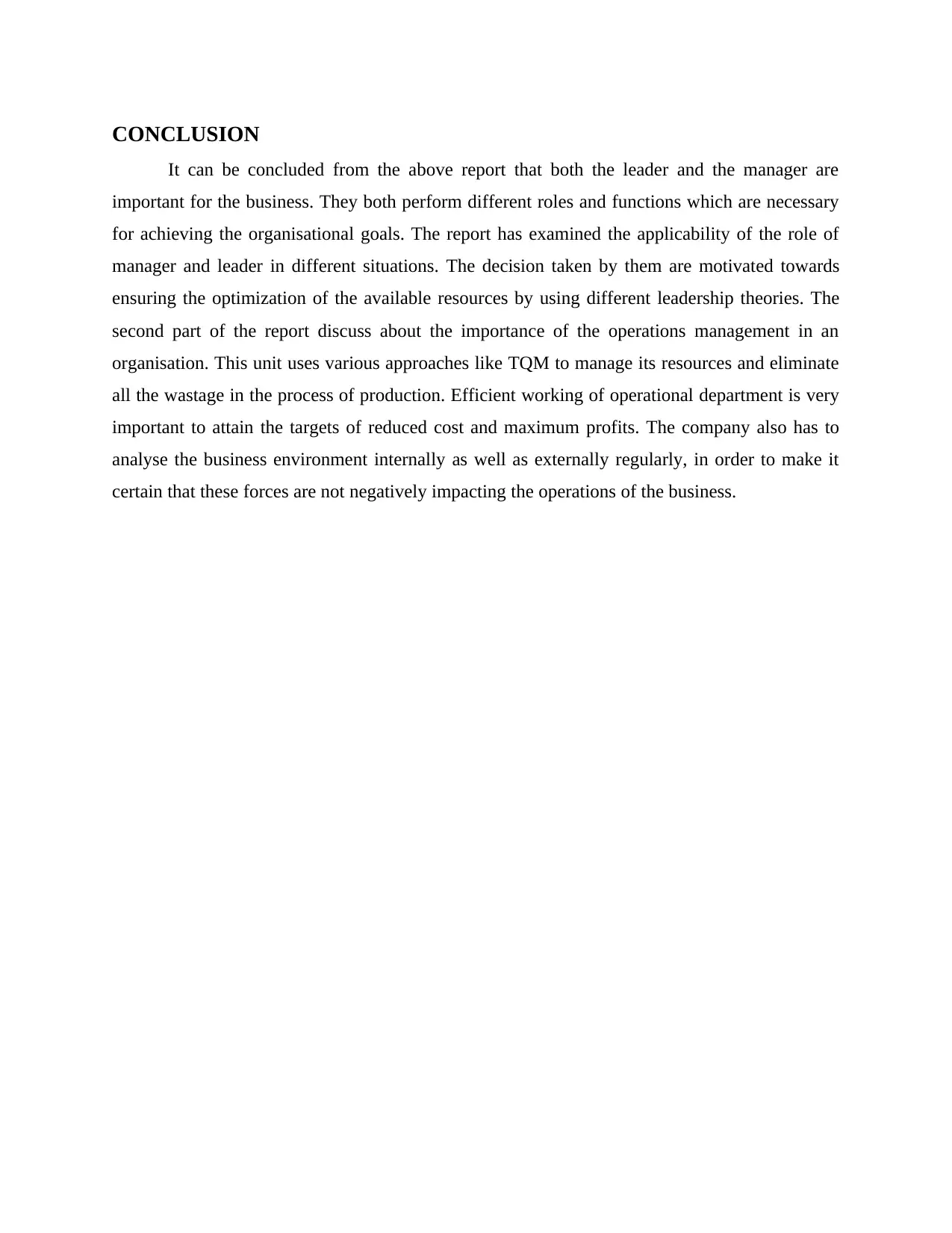
CONCLUSION
It can be concluded from the above report that both the leader and the manager are
important for the business. They both perform different roles and functions which are necessary
for achieving the organisational goals. The report has examined the applicability of the role of
manager and leader in different situations. The decision taken by them are motivated towards
ensuring the optimization of the available resources by using different leadership theories. The
second part of the report discuss about the importance of the operations management in an
organisation. This unit uses various approaches like TQM to manage its resources and eliminate
all the wastage in the process of production. Efficient working of operational department is very
important to attain the targets of reduced cost and maximum profits. The company also has to
analyse the business environment internally as well as externally regularly, in order to make it
certain that these forces are not negatively impacting the operations of the business.
It can be concluded from the above report that both the leader and the manager are
important for the business. They both perform different roles and functions which are necessary
for achieving the organisational goals. The report has examined the applicability of the role of
manager and leader in different situations. The decision taken by them are motivated towards
ensuring the optimization of the available resources by using different leadership theories. The
second part of the report discuss about the importance of the operations management in an
organisation. This unit uses various approaches like TQM to manage its resources and eliminate
all the wastage in the process of production. Efficient working of operational department is very
important to attain the targets of reduced cost and maximum profits. The company also has to
analyse the business environment internally as well as externally regularly, in order to make it
certain that these forces are not negatively impacting the operations of the business.
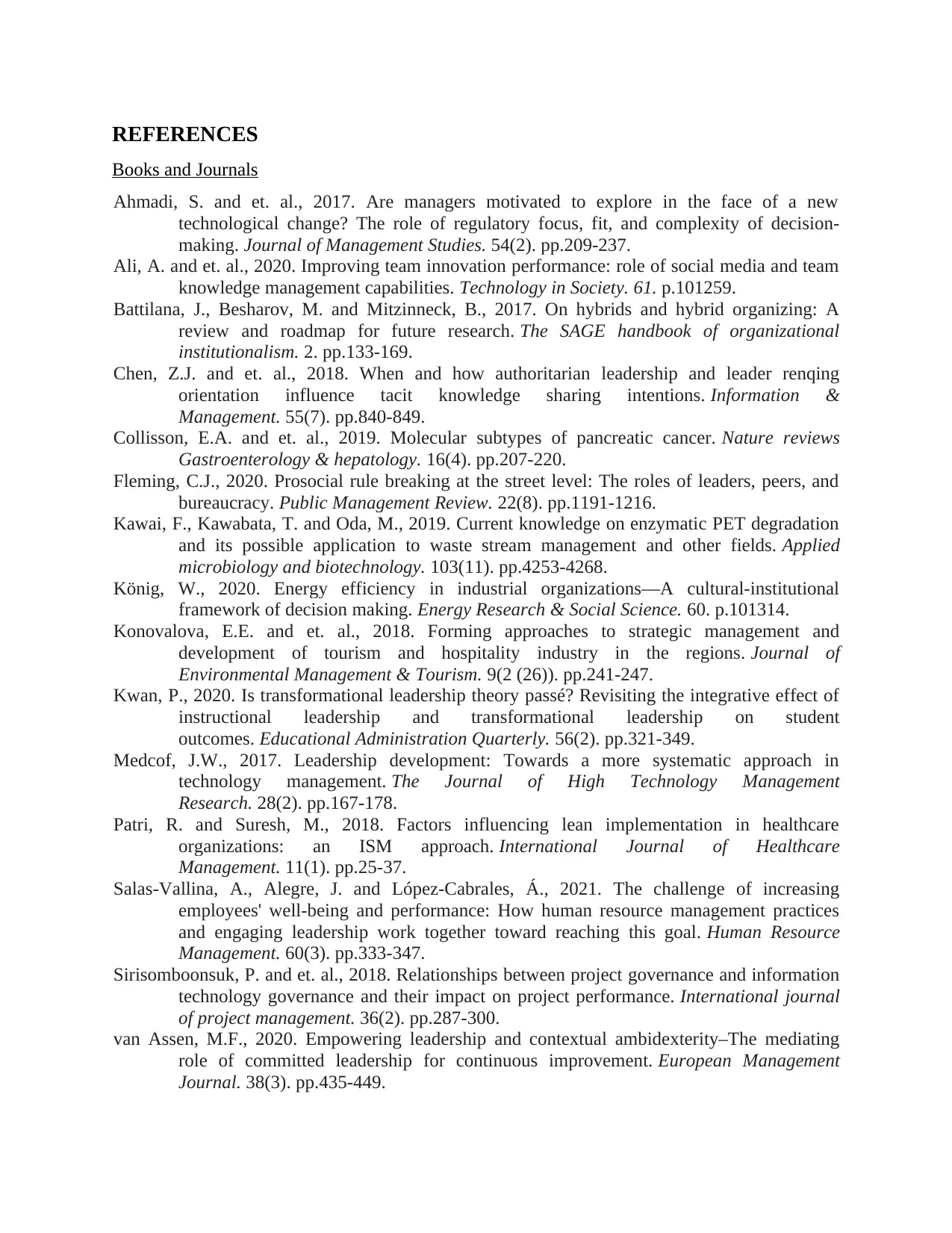
REFERENCES
Books and Journals
Ahmadi, S. and et. al., 2017. Are managers motivated to explore in the face of a new
technological change? The role of regulatory focus, fit, and complexity of decision‐
making. Journal of Management Studies. 54(2). pp.209-237.
Ali, A. and et. al., 2020. Improving team innovation performance: role of social media and team
knowledge management capabilities. Technology in Society. 61. p.101259.
Battilana, J., Besharov, M. and Mitzinneck, B., 2017. On hybrids and hybrid organizing: A
review and roadmap for future research. The SAGE handbook of organizational
institutionalism. 2. pp.133-169.
Chen, Z.J. and et. al., 2018. When and how authoritarian leadership and leader renqing
orientation influence tacit knowledge sharing intentions. Information &
Management. 55(7). pp.840-849.
Collisson, E.A. and et. al., 2019. Molecular subtypes of pancreatic cancer. Nature reviews
Gastroenterology & hepatology. 16(4). pp.207-220.
Fleming, C.J., 2020. Prosocial rule breaking at the street level: The roles of leaders, peers, and
bureaucracy. Public Management Review. 22(8). pp.1191-1216.
Kawai, F., Kawabata, T. and Oda, M., 2019. Current knowledge on enzymatic PET degradation
and its possible application to waste stream management and other fields. Applied
microbiology and biotechnology. 103(11). pp.4253-4268.
König, W., 2020. Energy efficiency in industrial organizations––A cultural-institutional
framework of decision making. Energy Research & Social Science. 60. p.101314.
Konovalova, E.E. and et. al., 2018. Forming approaches to strategic management and
development of tourism and hospitality industry in the regions. Journal of
Environmental Management & Tourism. 9(2 (26)). pp.241-247.
Kwan, P., 2020. Is transformational leadership theory passé? Revisiting the integrative effect of
instructional leadership and transformational leadership on student
outcomes. Educational Administration Quarterly. 56(2). pp.321-349.
Medcof, J.W., 2017. Leadership development: Towards a more systematic approach in
technology management. The Journal of High Technology Management
Research. 28(2). pp.167-178.
Patri, R. and Suresh, M., 2018. Factors influencing lean implementation in healthcare
organizations: an ISM approach. International Journal of Healthcare
Management. 11(1). pp.25-37.
Salas‐Vallina, A., Alegre, J. and López‐Cabrales, Á., 2021. The challenge of increasing
employees' well‐being and performance: How human resource management practices
and engaging leadership work together toward reaching this goal. Human Resource
Management. 60(3). pp.333-347.
Sirisomboonsuk, P. and et. al., 2018. Relationships between project governance and information
technology governance and their impact on project performance. International journal
of project management. 36(2). pp.287-300.
van Assen, M.F., 2020. Empowering leadership and contextual ambidexterity–The mediating
role of committed leadership for continuous improvement. European Management
Journal. 38(3). pp.435-449.
Books and Journals
Ahmadi, S. and et. al., 2017. Are managers motivated to explore in the face of a new
technological change? The role of regulatory focus, fit, and complexity of decision‐
making. Journal of Management Studies. 54(2). pp.209-237.
Ali, A. and et. al., 2020. Improving team innovation performance: role of social media and team
knowledge management capabilities. Technology in Society. 61. p.101259.
Battilana, J., Besharov, M. and Mitzinneck, B., 2017. On hybrids and hybrid organizing: A
review and roadmap for future research. The SAGE handbook of organizational
institutionalism. 2. pp.133-169.
Chen, Z.J. and et. al., 2018. When and how authoritarian leadership and leader renqing
orientation influence tacit knowledge sharing intentions. Information &
Management. 55(7). pp.840-849.
Collisson, E.A. and et. al., 2019. Molecular subtypes of pancreatic cancer. Nature reviews
Gastroenterology & hepatology. 16(4). pp.207-220.
Fleming, C.J., 2020. Prosocial rule breaking at the street level: The roles of leaders, peers, and
bureaucracy. Public Management Review. 22(8). pp.1191-1216.
Kawai, F., Kawabata, T. and Oda, M., 2019. Current knowledge on enzymatic PET degradation
and its possible application to waste stream management and other fields. Applied
microbiology and biotechnology. 103(11). pp.4253-4268.
König, W., 2020. Energy efficiency in industrial organizations––A cultural-institutional
framework of decision making. Energy Research & Social Science. 60. p.101314.
Konovalova, E.E. and et. al., 2018. Forming approaches to strategic management and
development of tourism and hospitality industry in the regions. Journal of
Environmental Management & Tourism. 9(2 (26)). pp.241-247.
Kwan, P., 2020. Is transformational leadership theory passé? Revisiting the integrative effect of
instructional leadership and transformational leadership on student
outcomes. Educational Administration Quarterly. 56(2). pp.321-349.
Medcof, J.W., 2017. Leadership development: Towards a more systematic approach in
technology management. The Journal of High Technology Management
Research. 28(2). pp.167-178.
Patri, R. and Suresh, M., 2018. Factors influencing lean implementation in healthcare
organizations: an ISM approach. International Journal of Healthcare
Management. 11(1). pp.25-37.
Salas‐Vallina, A., Alegre, J. and López‐Cabrales, Á., 2021. The challenge of increasing
employees' well‐being and performance: How human resource management practices
and engaging leadership work together toward reaching this goal. Human Resource
Management. 60(3). pp.333-347.
Sirisomboonsuk, P. and et. al., 2018. Relationships between project governance and information
technology governance and their impact on project performance. International journal
of project management. 36(2). pp.287-300.
van Assen, M.F., 2020. Empowering leadership and contextual ambidexterity–The mediating
role of committed leadership for continuous improvement. European Management
Journal. 38(3). pp.435-449.
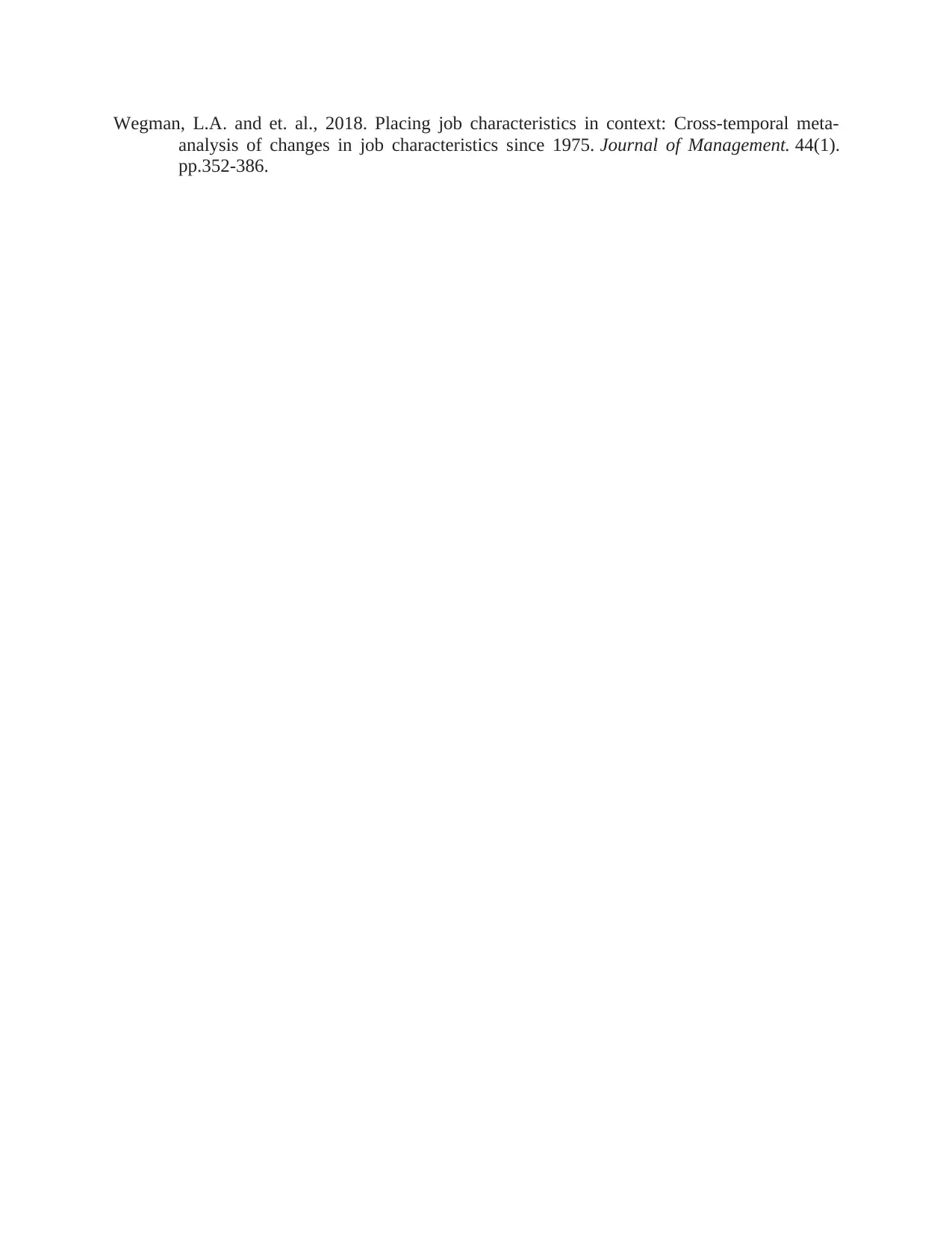
Wegman, L.A. and et. al., 2018. Placing job characteristics in context: Cross-temporal meta-
analysis of changes in job characteristics since 1975. Journal of Management. 44(1).
pp.352-386.
analysis of changes in job characteristics since 1975. Journal of Management. 44(1).
pp.352-386.
1 out of 13
Related Documents
Your All-in-One AI-Powered Toolkit for Academic Success.
+13062052269
info@desklib.com
Available 24*7 on WhatsApp / Email
![[object Object]](/_next/static/media/star-bottom.7253800d.svg)
Unlock your academic potential
© 2024 | Zucol Services PVT LTD | All rights reserved.




